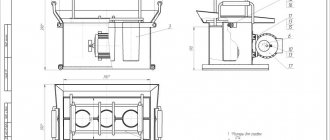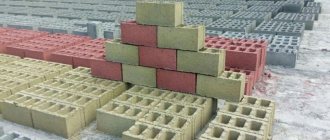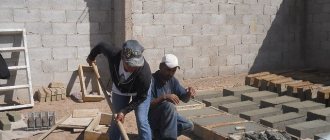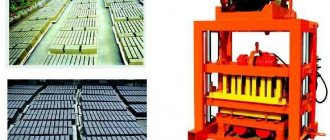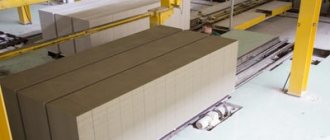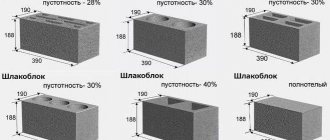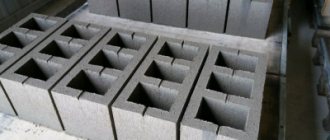Nowadays, the construction of one-story premises, both residential and industrial, is very popular. In most cases, these are garages, bathhouses, small buildings near the house. Each of the newly minted builders, of course, is looking for all sorts of ways to save their money without losing quality, because basically everything is done for themselves.
So, among the huge selection of building materials, we will focus on the most profitable at the moment - cinder block.
A manual machine that requires no effort when creating workpieces
Creating a Form
First of all, you need to decide what kind of machine you need. If you want to build a garage or temporary shed, then a machine with two or even one mold is enough. If you are going to organize a small business, then you will need a more productive machine, at least for 3-4 matrices.
Cinder block dimensions
The most important part of the machine is the shape. The remaining parts and assemblies are additions that allow you to perform various manipulations with this form.
For example - filling, lifting, compacting the solution, moving, etc.
When producing cinder blocks, the plant uses standard iron molds, as well as professional equipment that presses concrete into a mold under a weight of several tons. Do-it-yourself cinder block molds are most often made from wood. There are many types and designs.
In essence, the form is a container into which concrete is poured and where it remains until it hardens completely. It should be noted that the forms must be collapsible so that the finished cinder block can be easily removed. In most cases, they are even made without a bottom, and a plate of material to which concrete does not stick is placed under the bottom.
The easiest way to create voids in a block is to immerse plastic water bottles or glass champagne bottles, which is preferable, into soft concrete at the desired location. But, if you want to set up a small production of cinder blocks with your own hands, then the void formers must be fixed in the mold.
Sketch of a wooden mold
Made of wood
First of all, you will need planed boards, the width of which will correspond to the height of the cinder block. Then it is necessary to make the outer cross members, which will be connected to the longitudinal boards with “sliding grooves”.
Then cuts are made from the inside of the longitudinal boards at a distance equal to the length of the cinder block. The transverse grooves should have a depth of 7 - 8 mm. The width of the cut corresponds to the thickness of the separating plates, which can be made of iron, getinax, textolite.
Sketch of a form filled with solution
The plates can be made from other sheet material, the main thing is that it is smooth. The drawing above shows how to make wooden molds for cinder blocks with your own hands. It is advisable to open the mold details with any oil paint. This will make it easier to remove the cinder blocks from the mold.
Please note that the sketch shows smaller dimensions than a standard cinder block requires. Before creating the mold, you can make your own cinder block drawings
This procedure will not be superfluous and will not require much work.
The above forms are used without a vibrator. The solution in them should be poured into a softer solution with a higher water content. However, with a little effort, you can create a more advanced vibrating machine.
Form-stretcher
The molds for the vibrating table look a little different. Handles must be attached to the sides so that two people can lift them and place them on the vibrating table. There should be two cones at the bottom of each cell.
You should not make a mold with a large number of cells, as such a stretcher will be very difficult to lift. Such forms cannot be disassembled, and the cinder blocks from them are shaken out by tipping them over. The internal surfaces of the mold must be smooth so that the products can be easily removed.
The photo shows a metal form
Made of metal
When creating a machine for making cinder blocks with your own hands, you will need a steel sheet 3-5 mm thick. Shape elements should be cut out of it based on the size of the cinder block. The standard is 190x190x390 mm; in accordance with these dimensions, do-it-yourself cinder block drawings are made. The height of the form should be 5 mm above the block so that you can pour the concrete mixture and press it on top with a plate
Since the cinder block must be hollow, it is important to make the void formers correctly. The easiest way to use pipes for these purposes is
Please note that they need to be given a conical shape. Thanks to this, the product will be easily shaken out
Blanks can be ordered from a turner so that he can remove a few mm from one side of the pipe. Sometimes rectangular void formers are made. Their shape doesn't matter, the main thing is that they are conical. Keep in mind that the cinder block should be no more than 30% hollow.
A wooden or rubber seal should be made at the bottom of the mold along the perimeter to avoid deformation of the edges of the matrix. You can also weld metal plates 20 mm wide along the edges.
Vibrating table of the simplest design
What tools and equipment will be needed?
To make cinder blocks with your own hands, you need to prepare:
- sand sieve;
- bucket;
- shovel;
- molds for block production;
- concrete mixer or container for mixing the solution;
- vibrating table;
- hammer;
- trays for drying finished products.
You can buy a vibrating table, but if this is not possible, then compaction will be done with a hammer. Molds for pouring concrete can be made independently from iron .
It is important to take care in advance of the place where the stone will dry. If there are dents or cracks on the surface of the blocks, they will be unsuitable for further construction of the house. The stone must be dried on all sides, so placing it on a solid surface without perforation would be incorrect.
Making a vibratory pressing machine
Adding a slag concrete vibrator to the above-described production scheme provides the opportunity to significantly improve the quality of products and at the same time speed up the process.
It is not difficult to assemble such a machine; if you follow all the recommendations, this equipment will work no worse than its factory counterparts. The simplest version of a vibrocompression machine involves the use of a homemade matrix, a vibrator and a hand press. To reduce physical stress, the manual press can be improved by using a lever system.
Drawing of a homemade machine with a vibration motor for making cinder blocks and expanded clay blocks
A set of tools and materials necessary for the manufacture of a vibration machine with a metal mold:
- welding machine;
- Bulgarian,
- a set of keys;
- vice;
- sheet metal with a thickness of at least 3 mm;
- pipes for creating voids with a diameter of 8-10 mm;
- channels, strips of metal;
- low-power electric motor (up to 1 kW);
- connecting elements (bolts, nuts, cotter pins).
The sequence of actions when making a homemade vibrating machine:
- Using a grinder, we cut out the walls of the matrix from sheet material. If the mold is intended for the manufacture of several block products, we provide for the presence of the corresponding number of partitions in the matrix.
- We cut off the required number of blanks from the pipe (at the rate of 3 pieces per brick), the height of which should be 3-5 mm less than the height of the matrix. The taper of the pipes is achieved using the following technique: cut the pipe in half and crimp the workpiece in a vice (for thick-walled pipes you can use a lathe).
Drawing for the manufacture of a machine with lightweight extrusion of building blocks
- Each pipe section is welded tightly on both sides.
- We weld the plates to the pipes, connecting them together. For fastening to walls, it is better to provide a removable connection, which will allow, if necessary, to remove the limiters for the production of monolithic cinder blocks.
- Using welding, we attach bolts for attaching the electric motor to the long outer wall.
- We weld a metal apron on top of the form.
- We make a press in the form of a thick-walled plate, provide for the presence of holes with a diameter slightly larger than the smaller diameter of the limiter pipes (so that the press enters the matrix at a distance of no more than 50 mm).
- We weld the handles to the press.
- We install the motor. We weld an eccentric onto the electric motor shaft (ordinary bolts are suitable as material for the eccentric; they are welded parallel to the shaft and leave room for screwing on the nuts, which will allow you to adjust the amplitude of vibrations).
- We thoroughly clean the device, polish the surfaces, and paint the homemade unit for the blocks.
Composition of sand blocks
What a sand block is was discussed earlier. Sand block is a universal building material for walls and partitions in the house, the main materials for which are sand and cement.
In the manufacture of sand blocks, cement acts as a binder. Some craftsmen replace it with clay, gypsum or lime. However, it is still not worth giving up adding cement completely.
Sand is used as a filler in sand blocks
It is important that it is free of impurities in the form of earth or coal. An alternative to sand can be slag or granulation
The composition of sand blocks and its proportions are as follows:
- One part cement;
- Nine parts sand or slag;
- Water.
The calculation of materials for the manufacture of sand blocks is approximately as follows. From one bag of M500 cement, approximately 30 sand blocks are obtained. Moreover, to make one sand block, you will need approximately 15 kg of filler.
If we talk about large-scale production, then with 1000 kg of cement and 10,000 kg of sand, you will get approximately 600 sand blocks. This amount of material is enough to build a garage, the process of which has already been discussed on the website.
Sand block sizes
The weight of sand blocks, depending on their size, varies between 8-40 kg. In this case, the sizes of sand blocks can be different:
- Length 190-500 mm;
- Height 185-300 mm;
- Width 90-500 mm.
These dimensions are typical for wall sand blocks.
As for the fundamental blocks that are used when laying the base, their dimensions are much larger:
- Width 300-600 mm;
- Length 880-2380 mm;
- Height 280-580 mm.
To make sand blocks at home, you will first need to assemble molds that are installed on a vibrating table or other homemade device. To assemble forms for sand blocks, it is best to use wood, and the forms themselves should not have a bottom so that they can be easily disassembled into parts.
In addition, a distinctive feature of sand blocks is the presence of 2-3 voids inside. To organize them, you can use a bottle with which the finished mixture is pressed, or you can weld metal molds with two or three pieces of thick pipes inside.
Equipment for the production of foam blocks
A machine for producing foam blocks at home is a pressure unit.
Let's look at the 6 main reasons why you need to choose this particular unit:
- Unlike the classic foam concrete production scheme, in the installation the entire process is carried out under pressure. Therefore, when unloading the solution, the pores in it are much larger, which in turn will make the blocks lighter;
- Using a conventional pressure plant, you can easily produce foam blocks and foam concrete for various needs:
- Foam blocks of various sizes and configurations, which are suitable for the construction of low-rise buildings;
- Foam concrete mixture used to fill lightweight brickwork (for insulation and sound insulation);
- Small blocks and slabs that are used for internal and external wall insulation.
- You can produce foam blocks and foam concrete even in a small room or in the open air - the installation itself occupies an area of less than 1 m²;
- Using a pressure unit, you can significantly save on hired labor. You will not need people to supervise the operation of the foam generator;
- Even a child can be taught how to operate a pressure unit - with the help of this unit, producing foam blocks has become very simple;
- The production of foam blocks and concrete using a pressure setting is not only a cheaper way to build a house, but also an opportunity to earn good money.
Equipment for the production of large batches
Vibration pressing machine Sprut-2
- weighs 140 kg;
- consists of a matrix with two blocks, a vibration motor (380 V, 550 W), a frame, a pallet, a punch, a pallet remover;
- produces 600 – 1500 products (390×190×190 mm) per shift.
Automated vibration-pressor complex Condor 1-90-TB
- • in addition to expanded clay blocks, it produces thermal blocks, semi-blocks, cinder blocks, crossbow blocks, as well as facing materials, garden borders, paving stones, bricks;
- • weighs 1.57 tons;
- • has dimensions – 1.2x1.8x2.8 m;
- • consists of a die-punch, a 16.5 kW brick press, a 90 liter concrete mixer, a conveyor belt, a pumping station, a bunker, 5 pallets, a rack, a control panel;
- • produces 750 pieces of blocks (390x190x190mm), 1800 pieces of bricks (250x120x88mm), 50 m2 of paving slabs per shift.
Video: concrete block press Condor 1-90-TB
- designed for the production of wall blocks, curb stones, paving slabs;
- able to work not only under a canopy, but also in the open air;
- weighs 4.4 tons;
- has dimensions: 6400x4900x2600 mm;
- consists of a brick press with a power of 21.6 kW, a mixer, a dispenser, a pallet supply module, a mixture loader, an electrical cabinet, and an oil station;
- produces per hour 250 wall blocks (390x190x190 mm), 350 pieces of semi-blocks (390x120x188 mm), 500 pieces of curbs (780x150x300 mm), 200 pieces of curbs (780x80x200 mm), 625 pieces of paving slabs (100x200x70 mm).
Cinder blocks: composition and proportions
The cheapness of cinder blocks is due to the use of a wide range of materials as filler, many of which are waste from various industries. Accordingly, there are several recipes for mixing mortar, but cement remains the main component. Builders prefer to use Portland cement M400. If there are cement of other brands, the proportions will be slightly different: brands with a smaller number will require an increase in cement content by 15-20%, the use of higher quality cements allows you to reduce its content. In addition to cement, the solution for cinder blocks includes a filler and a plasticizer. Available materials can be used as filler:
- sawdust;
- dropout;
- ash;
- construction waste, including broken bricks;
- sand;
- small stones, gravel.
Plasticizer is an optional additive, but it improves certain properties of the solution. There are plasticizers that increase the moisture and frost resistance of the mixture, which is important for areas with harsh climates. You can find additives that improve the strength characteristics of the solution, prevent the formation of cracks, and accelerate the hardening process of the working solution. The percentage of plasticizers in the mixture is insignificant: 3-5 grams of the additive is enough to produce a unit of product.
The production technology itself and the composition of cinder blocks provide for the fact that the blocks use special devices and machines that can be made with your own hands
The name “slag blocks” was assigned to this building material, since in Soviet times it was mainly produced from coal slag, a waste product from metallurgical production. Today, other material can act as a filler, but as an example, we will give the proportions of the slag mixture:
- three parts slag;
- one part plaster;
- water.
The slag mixture is moistened before use. Preparing such a solution takes 5-10 minutes, while one cubic meter of the finished mixture will require approximately 340-360 liters of water. The addition of plasticizers improves certain characteristics of the mixture, increasing the cost of the cinder block. When using dyes, it is possible to obtain products with different colors, which improve the aesthetic perception of the building.
Description of manufacturing technology
Many private developers often wonder: is it possible to create high-quality cinder blocks on their own and how to do it? In fact, the procedure does not require special skills or complex algorithms. If you follow the basic recommendations and follow the instructions, the action can be completed in a short time.
Conventionally, the production procedure is divided into three stages:
- Preparation of concrete mortar, which consists of water, cement and any screenings. If necessary, it is supplemented with plasticizing additives, which have a positive effect on the quality indicators of the finished product, increase water resistance and resistance to low temperatures.
- Pouring the prepared composition into special molds. The concrete mixture is compacted through a vibration process. To do this, you need to purchase professional equipment or make a machine for the production of cinder blocks on your own.
- The last stage is to harden the blocks. At natural temperature conditions, this action takes from 36 to 96 hours. During this time, the mixture takes on a suitable shape and becomes ready for further processing. To speed up the process, special substances can be added to the composition.
If you intend to start producing high-quality building materials at home, be prepared to stock up on:
- Vibrating machine.
- Suitable materials.
- Relatively flat area.
- Access to an electrical network with a voltage of 220 V.
First you need to find a high-quality machine for making cinder blocks. Fortunately, these days such a purchase is not something difficult to obtain, since these devices are sold in many hypermarkets and construction equipment stores. And the device is easy to create with your own hands. However, if we are talking about mass production of the material mentioned, then it is better to give preference to a professional machine with high productivity.
Expanded clay block production technology
The production of expanded clay blocks consists of the following stages:
- Preparation of the working mixture.
- Molding of products.
- Pre-hardening.
- Drying of products and strengthening.
- Transportation of expanded clay concrete blocks to the warehouse.
Preparation of the solution
To prepare 100 kg of working mixture, take the following proportions, kg:
Cement grades M400 or M500 are used in dry and pure form. To obtain a glossy surface, tile adhesive is added to the mixture. The plasticity and workability of the solution is increased with the help of plasticizers.
Chemical additives increase the frost resistance and water resistance of finished products. To increase porosity, wood saponified resin is used.
Concrete mortar is prepared by thoroughly mixing the mixture components. A weighed amount of ingredients is placed in a concrete mixer or special container. The composition is stirred for 2-3 minutes.
From the finished portion of the mixture, 9-10 standard blocks measuring 39x19x19 cm are obtained.
Product molding
The prepared composition is placed in special steel molds. After each use, the molds are rinsed with clean water and wiped with a dry cloth.
The molds with the mixture are installed on a vibration stand. Under the influence of vibration, the mixture in the molds is compacted. As sedimentation and compaction proceed, the required amount of solution is added. Excess concrete is promptly removed.
How to make a matrix with your own hands
The mold for making a cinder block is the most important thing in the process and the most important thing in the configuration of the machine. Without the correct shape, the whole point of making a cinder block yourself becomes a useless circle of Skillful Hands. The more irregularities and voids there are in the cinder block, the longer the wall will take to build, and the poorer the quality of the masonry will be. During the manufacturing process on a vibrating table, slag concrete tends to shrink, and this is quite natural, since the whole point of the vibrating table is to compact the solution as much as possible, driving all the air out of it.
If the matrix does not take this into account, the cinder blocks will be of different sizes, and it will be very difficult to make normal masonry from them. Therefore, professional machines also use a press to quickly stabilize the mixture. The matrix drawings and the step-by-step process of its manufacture require no explanation. Everything is clearly visible in the photo, and by observing these dimensions, you will get the perfect cinder block.
Advantages of cinder blocks
The advantages of such building materials are as follows:
- such blocks are excellent heat insulators. Walls built from them are warmer than their counterparts made from traditional materials;
- due to their large size, the construction process is much faster than when using conventional bricks;
Cinder blocks are large in size
- the next advantage follows from the previous one - large dimensions allow you to use less cement mortar;
- is lightweight and does not cause excessive weight to the building;
- its price is low;
- You can make such blocks at home and this will require a minimum of equipment.
Cinder concrete blocks - characteristics and purpose of the material
One of the reasons for the increased popularity of slag-filled concrete blocks is the low cost of the material. It is associated with the use of waste from metallurgical enterprises - slag - in the production process.
Along with traditional components, Portland cement and river sand, various aggregates are used:
- brick break;
- crushed stone screening;
- granite chips;
- various slags and ash;
- expanded clay particles.
The use of cinder blocks in construction allows you to reduce the cost of constructing walls several times
The manufacturing process is carried out in various ways:
- industrial method at specialized enterprises with processing of products in drying chambers;
- at home from available raw materials, using a self-assembled machine for making blocks.
Using homemade equipment you can produce various types of slag concrete products:
- full-bodied, with an increased margin of safety. They are used quite rarely, as they retain heat less well;
- hollow, characterized by high thermal insulation properties. To ensure strength, the volume of cavities should not exceed 1/3 of the total volume of the product.
The dimensions of the products are determined by the dimensions of the mold. When making products yourself, the size of the molding box can be any. However, many people prefer the standard dimensions of 19x18.8x39 cm.
The increased volume of the slag concrete block can significantly reduce the duration of various types of construction work:
- construction of capital walls;
- construction of internal partitions.
It is perfect for the construction of utility buildings, sheds, and storage buildings.
If you need to make a cinder block yourself, the machine allows you to quickly solve the problem. The resulting material has many advantages:
- high thermal insulation characteristics. Due to reduced thermal conductivity, the material prevents heat loss;
- increased dimensions and low weight. This makes it easy to transport products and quickly build walls from them;
- resistance to the development of microorganisms. This is achieved due to the properties of the slag included in the structure of the block;
- low price. A cinder block machine with your own hands allows you to make products that are cheaper than purchased blocks.
The material also has weaknesses:
- low durability. The period of operation of buildings made of slag concrete is up to three decades;
- reduced safety margin. The characteristics of the material allow the construction of buildings no more than two floors high;
- the appearance of cracks under the influence of shear forces. During shrinkage, cracking occurs along the cinder block mass.
To ensure an attractive appearance of buildings, the cinder block surface needs external cladding. These disadvantages do not stop developers who want to build a utility building or a small building in a limited time at low costs.
You can use homemade cinder blocks a month after they are made.
Equipment overview
In order to produce foam concrete, it is not necessary to buy new equipment - used or mini installations can cope with the required volume. Now, in order to understand the equipment in more detail, we will consider each element of the system separately.
Pressure setting
Pressure installation - unique equipment
This unit is a machine for producing foam blocks with your own hands. Foam production and mixing are carried out using an activator built into the mixer.
Main advantages of the device:
- Using a mobile unit, you can deliver concrete directly to the work site;
- Reliability in operation;
- The resulting concrete is more cellular, and blocks prepared from this solution are lighter;
- No special qualifications are required to operate the unit;
- Ideal option for private developers or small construction firms.
Vibrating sieve
Vibrating sieve is a guarantee of high quality
Another unit without which you are unlikely to be able to prepare a high-quality foam block. It is designed for sifting and sorting sand and cement. The device consists of a mesh, a frame and a vibration motor powered by electricity.
When turned on, the vibration motor causes vibrations in the block with the sieve and the sand poured into it is sifted. Then it is poured along the tray into a general collection.
The main advantage is that the resulting homogeneous fraction of cement and sand can significantly improve the quality of the foam blocks you produce.
Compressor
The new compressor will last a long time
Another unit useful in many areas of construction. The single-stage, direct-drive piston tool is used with a fairly diverse selection of accessories and other air tools. In the production of foam concrete it is a mandatory element of the system.
Main advantages of the compressor:
- The oversized and lightweight compressor can be easily transported to the work site with your own hands;
- Aluminum heads and cylinder block (cast iron) with large cooling fins help to increase the service life of the unit;
- The electric motor is equipped with special protection against overheating;
- It is possible to adjust the outlet pressure.
Foaming agent
Without a foaming agent, you will not be able to prepare foam concrete. This mixture is highly stable (holds foam), which allows the finished mass to be transported over long distances without harm to the solution.
Depending on the desired density of the foam blocks, the foam concentrate consumption can range from 0.25 l to 1.2 l per 1 m³ of solution.
The foaming agent itself is sold in plastic barrels with a volume of 220 liters.
Specifications
Do not forget that in addition to the equipment and foam concentrate, you will need to carefully read the technical specifications of the production.
Fully assembled system
You have two good reasons for purchasing TU:
- With the help of technical specifications, you can familiarize yourself with the recipe for producing high-quality foam concrete;
- You simply cannot do without them if you decide, in addition to your own construction, to sell blocks to private developers. After all, to sell foam blocks you will need a special quality certificate for the products being manufactured. In order to receive this document, you will be required to provide the certification authorities with a sample of your product and a copy of the specifications according to which it was prepared.
Pros and cons of making it at home
The main advantage of this work is significant cost savings. Self-production allows a person to adjust the composition of the stone to suit his needs , but when purchasing, there is no such opportunity.
But there is also the other side of the coin: when producing with your own hands, you can make technological errors that will affect the quality of the stone.
In addition, the entire process is considered time-consuming.
Which is the best block machine to use?
Developers who decide to independently produce cinder blocks for the construction of walls are faced with the question of choosing equipment. It is not always possible to rent a machine for the production of building blocks, especially in small towns. Many people decide to make the equipment themselves. Depending on your financial capabilities, you can choose the following options:
- the simplest design that allows you to produce wall blocks at home at minimal cost;
- a modernized version of the unit, equipped with a compaction device and additional mechanisms.
It is difficult to give a definite answer as to which block production machine is preferable to use. It all depends on the number of blocks that need to be produced and financing possibilities. Let us dwell on the features of each unit.
Simplified block machine
To make cinder blocks on your own in a reduced quantity, it is not necessary to make a mechanized unit, use a vibrator, or additional mechanisms. The manufacturing process using simplified technology can be carried out in special forms.
Simplified block machine
Procedure:
- Assemble the molds and coat their inner surfaces with waste oil.
- Pour cinder block mixture into collapsible molds.
- Leave for 3-4 hours until the solution hardens.
- Disassemble the containers and carefully remove the blocks.
- Allow to dry indoors.
If it is necessary to produce hollow products, it is advisable to use ordinary drink bottles to form cavities. A simplified machine for the production of blocks, which is a container of the required size made of wood or steel, can be manufactured at a minimum amount of cost.
Modernized machine for the production of building blocks
With an increased need for cinder blocks for the construction of a large building, you can make a more complex machine for producing blocks, equipped with special devices:
- vibration mechanism. An electric motor is used as a vibration motor, with an eccentric located on the drive shaft. The drive power depends on the size of the mold, the mass of the slag concrete solution and is 0.5–1.5 kW. Under the influence of vibration, the slag concrete mass is compacted, the material is evenly distributed throughout the entire space of the mold, and air inclusions are removed. As a result of compaction, the specific gravity and strength of cinder block products increases;
- lifting device. It is designed for accelerated extraction of finished products from molding containers. There are many design solutions to speed up and facilitate the removal of blocks. In the simplest version, it is enough to weld handles of any shape to the molding container, by pulling which you can remove the hardened block. Using ready-made drawings, you can independently assemble a lever mechanism from scrap materials.
Modernized machine for the production of building blocks
The shape used in this unit must correspond to the size of the cinder block that is planned to be made. In most cases, products are manufactured of standard dimensions - 0.4x0.2x0.2 m. The molding container must have a height increased by 4m5 cm so that the molded block after compaction has the required dimensions. To simulate cavities, pipe scraps of the required diameter can be welded to the bottom of the container.
Table
Taking into account the total weight of the matrix and concrete solution, as well as vibration during the manufacturing process of the blocks, only metal is used as a material. The photo shows several possible table options.
Its task is to use vibration to ensure compaction of the solution, which achieves the required strength of the artificial stone. The method of “controlling” the vibrating table is manual or electric.
Engine power does not have much effect on vibrations. It is enough to take a product from a household appliance, for example, a used washing machine. The main thing is to ensure an optimal shift in the center of gravity, which causes the tabletop to oscillate. How to do this depends on capabilities and skills.
The first is using bolts that are located perpendicular to the shaft axis. The amplitude and speed of vibration are regulated by screwing the nuts on them.
The second is to install a washer whose center of gravity is shifted.
If difficulties arise related to the process of constructing a specific model, it would be useful to read articles on the relevant topic (for example, what is an eccentric and the principle of its operation), and remember the lessons of physics.
The tabletop is attached to the frame using springs. They are easy to pick up, for example, from decommissioned equipment. Sofas are clearly not suitable, since they must be quite hard and durable.
Since it is much more convenient to work with a mobile machine, the frame should be equipped with wheels.
Types of building blocks
Brick is still the main material in the construction of high-rise buildings, but for low-rise construction it is cheaper to use other building materials. If you exclude wood, which is now expensive, the choice will still be varied. Modern wall materials are made from:
- foam concrete;
- slag concrete;
- aerated concrete;
- expanded clay concrete.
Block characteristics comparison table
As a filler for cinder blocks, a variety of and sometimes exotic materials are used, which are industrial waste: screenings, broken glass and bricks, sawdust, wood chips.
Let's first consider how expanded clay blocks and cinder blocks are made independently, as the most budget-friendly among all the above building materials.
Block production process
Vibrating machine for block production.
Composition of concrete mortar for such blocks (in parts):
- slag (preferably blast furnace, without ash and coal) – 14 parts;
- coarse sand (expanded clay) – 4 parts;
- gravel with granule size 5-15 mm – 4 parts;
- cement (M400-M500) – 3 parts;
- water – 3-6 parts.
Slag, coal combustion waste, brick waste, expanded clay, perlite, crushed stone, sawdust, etc. can be used as filler.
It is important to monitor the water content in the mixture. The solution should crumble when falling to the ground, but when squeezed in a fist, it should come back together
First, the dry ingredients are mixed, and only then water is added to them.
The sequence of operations when making blocks on a vibrating machine:
- a solution with a slide is placed in the mold;
- the vibrator is turned on for 3-5 seconds, the solution settles;
- if there is not enough solution, add it, insert the punch (clamp) and turn on the vibrator again;
- molding is completed when the clamp sits on the stops;
- turn on the vibrator for another 5-10 seconds and remove the form while the vibrator is still running.
The blocks should dry within 5-7 days, but it takes about a month to completely harden.
How to prepare a solution for a machine for making cinder blocks
It is important to prepare the solution correctly so that the cinder block made at home has the required properties. Necessary materials:
- coal ash or metallurgical slag;
- sifted sand;
- fine-grained crushed stone or screenings;
- cement M400 or M500.
The name itself speaks for itself of what this block is made of, and it is made from coal slag, which remains after heating boilers in a coal boiler house.
Use the following recipes:
- mix ash with cement in a ratio of 7:2, add water until it reaches a plastic consistency;
- mix the ash and screenings in equal proportions, add 10–12% of the total volume of cement, dilute with water.
When mixing, follow proven recipes.
Stages of making molds for blocks with your own hands
To make metal matrices, you will need a 3 mm steel sheet and a 8 mm D metal pipe to form voids, as well as a grinder, a welding machine, and other working tools.
- Blanks for the walls are being prepared. They can be cut at home with a grinder 450x210 and 220x210 in 2 zigs. The bottom of the mold should have a side 3-3.5 cm high and a handle. Notches are made on the walls (f.3).
- To make voids you will need cylinders (photo 4). To do this, the required number of blanks is cut from the pipe at the rate of 3 units. for 1 block. The height should be a few mm less than the height of the walls. To give the pipe blank a conical shape, on one side you need to cut the pipe halfway and clamp it in a vice. Each pipe blank must be welded on both sides, resulting in hollow plugged cylinders (fillers). They are welded to the bar, then inserted into the mold and the bar is welded to the walls of the mold (f. 5).
- All seams must be welded from the outside.
- From a thick-walled plate we make a press with holes with a diameter exceeding the diameter of the hollow cylinders. The press should enter the matrix approximately 50 mm. Handles are welded to the press (photo 6).
Do-it-yourself ready-made forms for blocks do not require large expenses. People who do not have special qualifications can work with them. The main thing is to do the correct kneading and compact the contents.
How to make a machine for the production of expanded clay blocks yourself?
A machine you create yourself will cost 10 times less than a factory machine. The simplest homemade installation includes a molding box without a matrix (bottom) and a vibrator placed on the side wall. The removable matrix is prepared manually.
This machine can produce blocks with dimensions of 390x190x188 mm, with a void percentage of no more than 30%. The shape of the voids can be round or rectangular. The void former must be cone-shaped, then the form can be easily removed from the block.
Making a matrix is quite simple:
- take measurements from the block shape;
- cut out the corresponding blank from a sheet of metal with a 3-mm
- take measurements from the block shape;
- we cut out the appropriate blank from a sheet of metal 3 mm thick (it is advisable to provide a margin of approximately 5 cm for compaction);
- We make a through box from the blank (without a bottom);
- We make the welding seam from the outside.
To ensure stability of the machine, thin profile pipes can be welded at the ends of the box. Then apply rubber upholstery around the perimeter of the base. And to prevent the solution from spilling, you need to make an edging apron.
You can use a 150 W washing machine electric motor as a vibrator. You just need to achieve a shift in the centers. A metal strip with a side hole - an eccentric (its parameters are determined by experiment) is attached to the shaft.
